Anthropo-entomophagy: Cultures, evolution and sustainability
Abstract
Environmental cycles and human factors have altered ecosystems throughout the world. Natural resources have acquired high value because they are important to life and the survival of human beings. Among these resources are edible insects. They have many important features and, to date, up to 2086 species are consumed by 3071 ethnic groups. Rural people, who primarily search, gather, fix, commercialize and store this important natural resource, do not exterminate them. This is because rural people exploit only the central part of the insects' population curves. Nonetheless, some species are overexploited. Anthropo-entomophagy (eating of insects by humans) constitutes a major source of nutrition and these foods are eaten in 130 countries, with the African and American continents being the most entomophagous until now. It exists in protocultures (care is given to the edible insect species) and formal cultures, such as in Mexico, which date back to prehisphanic times. According to anthropologists the “saving gene theory” is based on insect ingestion, which, since the Paleolithic era, has given human beings reproductive success. The evolution of anthropo-entomophagy has been achieved in many ways, from the point of view of collection, fixing, marketing and consumption, and for the insects' organoleptical qualities. The sustainability of these species is fundamental; therefore, it is necessary to take certain measures for species conservation. In Mexico, more than 100 species of edible insects have been tested for their sustainability over 500 years, from the Spanish conquest to the present.
Introduction
Species conservation is of primary importance because of global warming, the extent of pollution in the environment, the high number of migrants (INEGI 2005) who have forgotten traditional knowledge about natural resources, the degree of urbanization in the younger generation, and globalization. Additionally, the view of natural resources existing solely for exploitation by humans that is common in developed countries is contrary to the holistic view adopted by rural populations (Toledo 1992). It is known that Mexico, USA, Europe, South Asia, Arabia and Northeast Africa have used more than 50% of their biocapacity because of resource exploitation, which is in contrast to Canada, South America, Russia, Finland, Central and Southern Africa and Australia, which have used less than 50% of their biocapacity by resource exploitation. Additionally, other countries as Venezuela, Panama, Sweden, Afghanistan, Turkmenistan, Kazakhstan, Uzbekistan, Kirguistan, Georgia and Azerbaijan and some parts of Central Africa have used from 0 to 50% of their biocapacity due to resource exploitation (Fig. 1) (WWF 2008). Most important is that one in every six habitants of the 6000 million people on the planet die from hunger and undernourishment (FAO 2008).
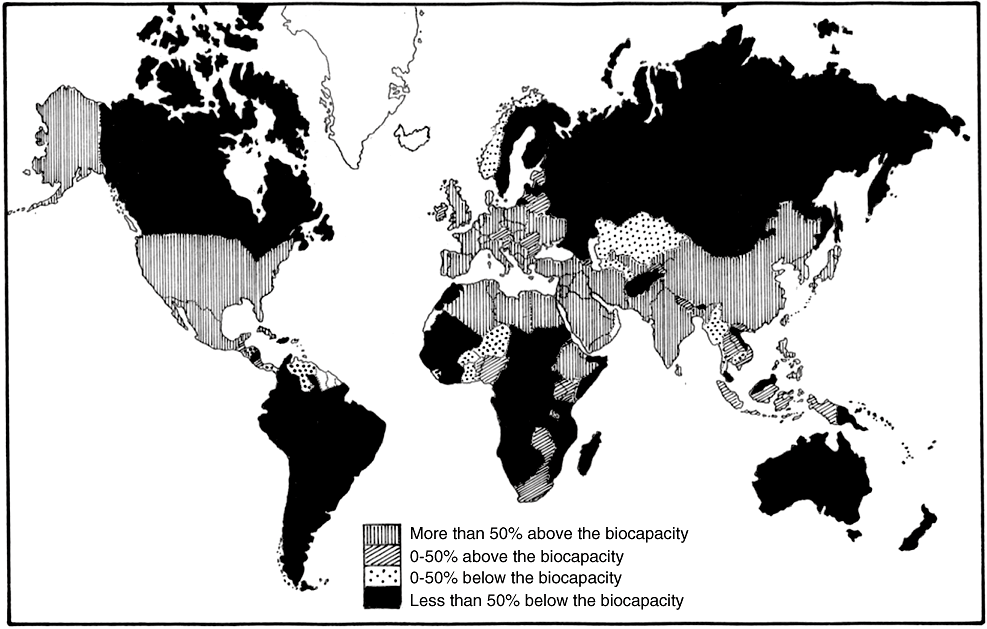
Biocapacity in the world (modified from WWF (2008)).
We can say that human beings have achieved space travel and created intelligent buildings and processed food, which show advanced technology and produce a large impact on our lives. However, when we look at human evolution in biological and sociological development, we can remark that these developments have been low and not very significant (Abrams 1987). For example, there still exist isolated areas with minimal development, which have remained for millennia and are called disadvantaged, those who have been persistently excluded from the rest of the world, but where ecosystems are generally found to be sustainable (Ramos-Elorduy 2006). These contrast with many other areas that follow so-called “progress” (high productivity), but which causes the disappearance of wildlife and where resources have neither value, meaning nor any particular use, where a change of the landscape and the ecosystem itself is totally different, or even the methods of sowing and harvesting are very distinct.
In light of the above, species conservation is today of primary interest because it means life. According to Posey (1990), indigenous people conserve 90% of the planet's germplasm. This highlights the appreciation that indigenous people have towards resources. Their primitive methods have permitted sustainable use of resources that leads to the survival of species.
However, as time has passed, natural resources have acquired values that they never had previously, not only because of their role in the net of living organisms, but also because of the uses that human beings have given them. At the current rate of resource use, scientists believe that humanity will consume the amount of resources equivalent to that of two planet Earths by the year 2050 (WWF 2008). About half of all countries already consume more than 50% of their resource biocapacity (which means half of their total resources), while some consume less and a few other countries have reached their limit (WWF 2008).
Materials and methods
This investigation is based in 29 years of field work on edible insects in different regions of Mexico and in other countries. We also widely consulted authors and libraries in many parts of the world, and researched via the internet. We conducted research in 831 localities where we recorded 549 species of edible insects belonging to 15 orders of Insecta (Ramos-Elorduy et al. 2008) (Fig. 2).
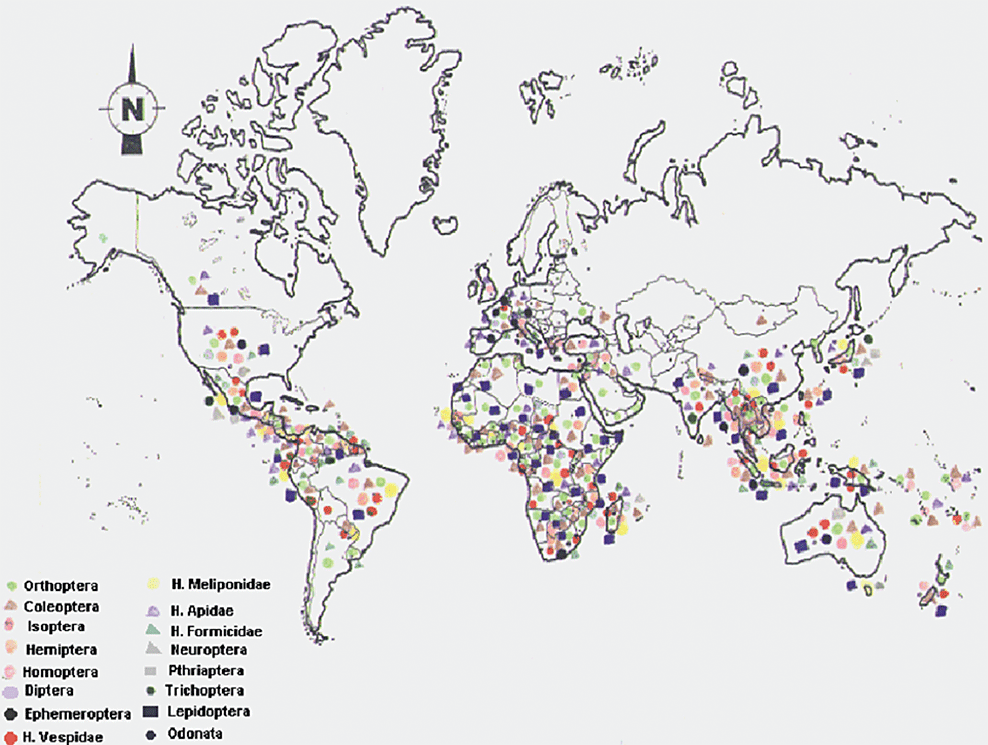
Distribution of edible insects in the world (modified from Ramos-Elorduy 2005).
Results
Food implications
From an anthropological socio-historical point of view of alimentation, it is necessary to understand the perceptions, conceptions, representations and universal symbols (3, 4) that are tied to the social imagination of each community. These symbolic representations include those of the body, health, disease, aesthetic, corporal models, the establishment of schedules, type of food, and when and what to eat. These represent our social and cultural identities and the psychological ownership in a social group.
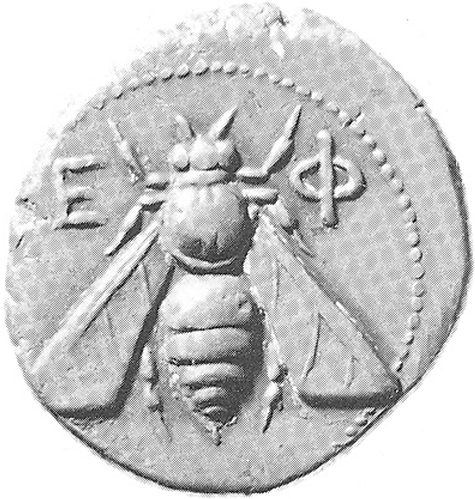
Roman coin with bee Apis mellifera Linneo.
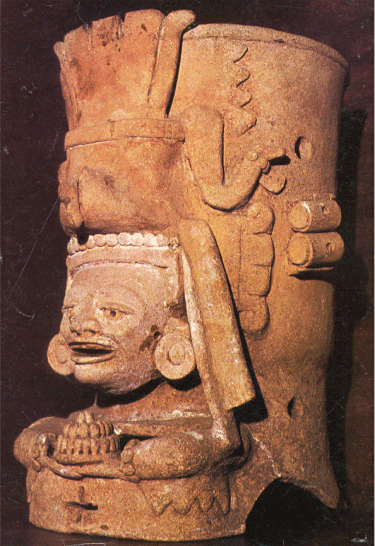
Deity Ah Mucen Cab of Maya culture representing the species Melipona beecheei Bennett.
Food changes the structure of societies and, consequently, has an impact on the social casts and conflicts that give rise to various aspects of economics and culture.
Cultural patterns go from the psychological processes of appetite and satiety to the representations that give a personal structure to dietary patterns. The community thereby depends on the type of environment, locality where they are settled and the ecosystem that surrounds them, which can be either very rich or limited in species.
Therefore, food is an important social context; however, as a result of globalization, there exist fewer flavors and more diet homogenization, and there has been a standardization of flavors, shapes, colors and type of food. As a result, now people feel food has become “plastic food” (Cordon 1988).
Currently, there exists an excess of patterns for food that range from the rules of parents to chefs, industry and especially mass media (radio, television, newspapers); the latter plays the greatest role in assessing the prestige of food. This is clearly seen in the case of edible insects, as the number of places where they are served has increased, as has their presence in the various media. Articles or reports are continually addressing this, which further increases the prestige of edible insects.
The worldwide food industry manages pricing and advertises to us what we must eat. As a result, food is treated as a commodity rather than as nutrition. Therefore, as Harris (1998) writes “we do not eat what we want, but what enterprises want to sell us and not sold what possess high biological value, but which produces high profits”. Furthermore, we do not know the origin of what we eat, the nutrients that have been lost in the process, the form of culture or raising, whether or not it is transgenic, or which types of additives and/or artificial sweeteners they have, in addition to other unknown variables.
While food is a physiological need, it also involves the engagement of the senses and can therefore give rise to pleasure. The food habits of a people express their beliefs and cultural traditions and are linked to the environment and to the availability of food. The factors involved are economic, religious, psychological and pragmatic (Contreras et al. 1995; Harris 1998).
These habits are changing in response to new lifestyles, products and types of food. Changes in these habits are also related to the increase and diversification of resources and to the increase in contact with different cultures. The final choice is among these variables that determines the changing profile of a diet. There is also a relationship between body image, self-esteem and advertising (Contreras et al. 1995).
Therefore, food is the expression of various dimensions: price (economic dimension); appearance, color, size, texture and smell that are its characteristics (physical dimension); prestige and timing of consumption (social dimension); acceptance or rejection in a culture (psychological dimension); hygiene conditions of the product (food security dimension); and by the handling and preparation (dimension of comfort use) (Contreras 1993). These are conditioned by economic factors and taste, ease in preparation and finally by its nutritional value.
In food, we found “neophilia” (tendency to explore novel foods coupled with a need for change and increase selections) and its opposite “neophobia” (fear of the unknown and resistance to accept new foods) (Rozin 1976).
Anthropo-entomophagy: An ancient alimentary habit
Humans initially had an insectivorous diet. Then, with subsequent evolution came fruits, vegetables and meat (hunting), where humans ate other mammals. Before hunting, humans were scavengers and later omnivorous (Valadez 2003). Their adaptive evolution was led by sociology because humans need cooperation to resist predators.
The ability to cultivate land in the Neolithic period increased the contribution of carbohydrates to the diet and provided satiety. This has led to a change from the nomadic to the sedentary lifestyle, which promotes obesity, pollution and overcrowding, and a shortening of reproductive intervals (4 years in the Paleolithic) (Abrams 1987). As a result, the population increases, which leads to the creation of social classes that have distinct access to food and quality of life, and thus, causes malnutrition in the lower classes (Bongaarts 1980).
The “meat share” was an important contract among the hunter–gatherers (Enloe 2003). In the Paleolithic, human beings were an example of social, but not economic, equality (Tommaseo-Ponzetta 2005).
Women looked after and preserved much of the germplasm of animals and plants. Women were also in closer contact with edible insects.
Symbols of edible insects
Insects are seen as a means to gain strength, vigor and spirituality, and are therefore consumed to achieve these attributes. For example, wasps indicate prosperity, protection and abundance.
Edible insects that have existed since antiquity were taken as a utilitarian resource or became, at times, sacred objects, such as the sacred beetle Ateuches sacer L. in Egypt. This resource therefore originated the formation of beliefs and legends that are part of world traditions. Among the most important in Mexico is the “sacred jumil”Edessa cordifera Walker (Fig. 5), which is regarded by the people in the state of Guerrero as a “watchman” or “guardian of the place”, living in the high mountains and believed capable of direct communication with God. Souls of ancestors, with their qualities, were believed to be introduced internally, when people ate these insects; thus, these peasants called them “family” (Ramos-Elorduy 2003). Other examples are Melipona beecheii Bennett “Water of youth” and lice, which act as messengers in Yucatán (Recinos 1947) and the thousand-headed serpent Latebraria amphipyrioides Guen. (Fig. 6) in Chiapas State (Ramos-Elorduy & Pino 1989). Equally important are the Pogonomyrmex spp. of ants, who told Quetzalcoatl (Teotihuacán's deity) that corn should be stored to provide food in times of scarcity (Velásquez 1975).
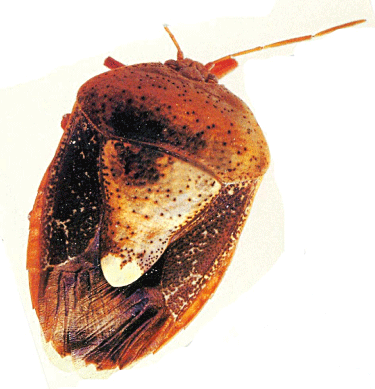
Sacred bug Edessa cordifera Walker in the Tlapaneco culture.
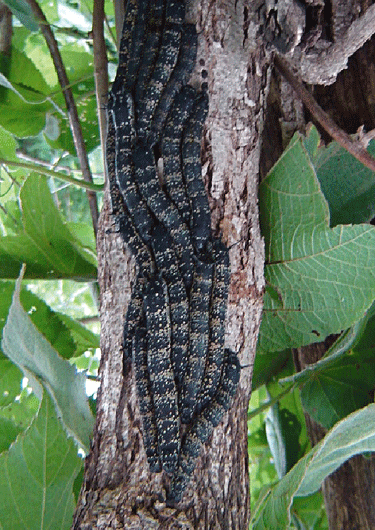
Thousand-headed serpent Latebraria amphipyrioides Guen.
Hindus believe that the bee Apis laboriosa F. Smith is the only animal that can communicate with God. The Chinese placed a cicada in the mouth of the dead (Duret 1995). In the Egyptian ruins of Karnak is a column where the sacred scarab is carved, where it was believed that people would have good luck if they turned around. The existence of sculptures of Apis in the columns of this temple reminds people of the qualities of this insect (organization, diligence, obedience, efficiency, solidarity). In Alaska, the deity of the larva of a fly that parasitizes reindeer Hypoderma sp. is adored (Bergier 1941).
In Africa, edible insects have a higher economic value than anywhere else in the world. Insects were fashioned in gold and used for weighing the gold that was mined and traded (R. Pujol, pers. comm., 1990).
Changes in cooking edible insects
Generally, all countries that now are called the developing world suffers from hunger and malnutrition; these diseases affect more than 50% of their population. The remaining 40% either have adequate food or are supercharged (North America, Japan, Europe and privileged minorities in developing countries). The USA makes up 10% of the world population and consumes 70% of all food available (Pimentel & Pimentel 1996).
There is a new vision that goes by the saying “technology is beautiful” where productivity grew and increased, new food products emerged. We were told that these foods were better, different, more nutritious, more appealing and more prestigious, and also that the structuring of our culture extends the values of economic efficiency to all levels of social life. Break down the transcendental values such as religion, justice, honor and dignity, and the result is the death of ideologies. However, this is the destruction of all native and indigenous cultures (Celi 2003).
In addition, women are currently in the labor market and the time available to prepare food has therefore been reduced. As a result, people have looked for easy and fast foods to prepare, gradually losing culinary traditions, increasing the solitary food type and leading to the breakdown of the commensalism that leads to social fragmentation and eating cheap products that are high in calories, fats and carbohydrates, but low in protein and micronutrients. Then, malnutrition progresses to obesity with malnutrition.
Nowadays, the process of eating food has become ambulatory (Navas 2000). For example, in Thailand edible insects are sold at street stalls (J. Ramos-Elorduy, unpubl. data, 1981) (Fig. 7).
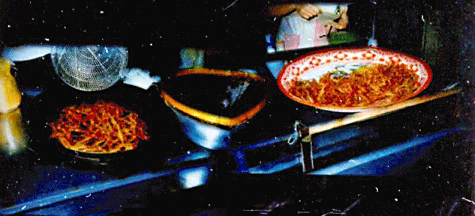
Preparation (boiling in hot water and frying) of rice grasshopper (Oxya velox) in Bangkok, Thailand in 1990.
Today, because of the scarce time available to us, we must constantly choose how to eat; whether it is rich, healthy, and fashionable, or quick and cheap.
Arana (2003) explains that a spontaneous cultural evolution has occurred, which has led to anthropo-entomophagy to be fashionable in the USA and Europe, making insects gourmet dishes, which, says Sutton (1990), is caused by the destruction of the environment and a scarcity of large wild animals.
Archaeological and anthropological data
The practice of insect ingestion has existed for a long time. Anthropo-entomophagy is a traditional alimentary habit that originated in the Paleolithic era (7000 years ago (Hernández-Pacheco 1921) as evidenced by testimonies in the form of pictures, sculptures, totems or deities that survive to this day (Darchen 1974).
Pager (1973), discovered ancient rock paintings in Natal, South Africa where one can appreciate the image of honey collector, who carries a sack on his back, using several lianas to form a ladder to reach the bees' nest. Furthermore, in the Matopo Hills, a rock was found with a painting that showed a person smoking a lit torch at the entrance of a bees' nest in Zimbabwe.
As previously mentioned, each alimentary habit is transforming in relation to the evolutionary circumstances of the society, which varies among ethnic groups and countries.
In the USA, particularly in the Great Basin, edible insects were collected by the indigenous people, dried and stored in empty trunks (Sutton 1988). In Mexico, insects were stored in ceramic pots dating back 3000 years (R. Muñiz, pers. comm. 1998). In Australia, insects were dried and stored in empty squashes (Bergier 1941).
The “saving genes” theory was based on the ingestion of insects by hunter–gatherers. According to archaeologists and anthropologists, edible insects gave reproductive success to humans, keeping their fat in the abdomen and buttocks (Bongaarts 1980; McGrew 1981). As a result, they assert that we have a Paleolithic body living in a postindustrial society (Abrams 1987).
Very often, these insects have been poorly identified (Osborne 1973). The term “locusta” has been applied indiscriminately to grasshoppers, crickets or cicadas, while the term “worm” has been used to name a few larvae of beetles (Speight 1974).
We can say that insects, as well as other resources, saw the birth of the human species. With time, this co-evolution and synergy decreased when humans left the field and became sedentary (Bochatay 2003).
Insects: An old natural renewal resource
Among these natural, renewal resources are insects, which have many features in their favor including number, reproduction and nutritional value, besides their presence in every ecosystem (Borror et al. 1976). However, we can assess that, in all cultural groups, there exist animals or vegetables that are pleasant and savory, and therefore are sought, as well as foods that are refused by people and on occasion become a taboo. The opposite can also occur and the resource becomes the object of admiration and veneration, having a high aesthetic, philosophical, mystical or cultural value that varies according to the ethnic group and the insect type. Edible insects are a large source of animal protein, generally having very good nutritional value with regards to proteins, fats, lipids, vitamins, minerals and salts, in addition to having an appetizing flavor. Insects are consumed at all stages of development, which, depending on the species, can be eggs, larvae or nymphs, pupae and/or adults among Pauro, Hemimetabolous or Holometabolous. This is not surprising, as insects form 80% of the animal kingdom and constitute a large biomass in the planet where they have existed for 350 million years (Borror et al. 1976). Furthermore, they have unique adaptations to the surrounding environment and an enormous variety of situations and diverse circumstances, both biotic and abiotic.
Most edible insects are gathered either manually (Fig. 8) or with the use of nets, axes, shovels or knives (Ramos-Elorduy 1997). Some species with the captured biomass are shown in Table 1.

Gathering edible grasshoppers in Hidalgo State, Mexico.
| Insect group | Biomass | Country | Species (reference) |
|---|---|---|---|
| Grasshoppers | 9 tons/year | Algeria | Locusta and Schistocerca (Gunn 1960) |
| 10 tons/year | Thailand | Oxya velox (IFNL 1987) | |
| >10 tons/year | Mexico (Oaxaca) | Sphenarium genus (Ramos-Elorduy 1996) | |
| 5–6 tons/year | USA | Anabrus simplex (De Foliart (1989) | |
| Termites | 1331 kg/month | Zaire | Macrotermes spp. (Kitsa 1989) |
| large quantities | Philippines | Macrotermes gilvus (Phelps 1988) | |
| large quantities | African Central Republic | Bellicositermes sp. (P. Roulon-Doko 1998) | |
| large quantities twice a year | Indonesia (Java) | (Wasosky 1992) | |
| Bugs | 3 tons/family/year | Mexico (Tulancalco, Hidalgo) | Pachilis gigas (Ramos-Elorduy 1996) |
| 5 tons/family/year | Mexico (Cuautla, Morelos) | Euschistus spp. and Edessa spp. (Ramos-Elorduy 1996) | |
| Butterflies and moths | 280–300 tons/year | Zaire (Kwango) | Anaphe, Bunaea, Lobobunaea, Nudaurelia, Gynanica (Leleup & Daems 1969; Bahuchet 1972, 1978; Malaise & Parent 1980, 1991, Kodonki et al. 1984, 1987; R. Pujol, pers. comm. 1990) |
| 5 tons/year | Zaire (Kwango) | Anaphe, Bunaea, Lobobunaea, Nudaurelia (Adriens 1951) | |
| 35 kg/year | South Africa (Bapedi ethnic group) | Gonimbrasia bellina (Quin 1959) | |
| 20 kg/year | South Africa (Pedi ethnic group) | Gonimbrasia bellina (Quin 1959) | |
| 150 k/person | Zaire | Gonimbrasia bellina (Muyay 1981) | |
| 140 k/person/year | Zambia | Mopanie worms (Gonimbrasia bellina) (Holden 1991) | |
| 1600 k/year | Zimbabwe, Botswana | (Dreyer 1988) | |
| 2000 k/year | India | Bombyx mori (Ichponani & Malek 1971) | |
| 3000 k/year | Mexico (Chiapas) | Latebraria amphypirioides (Ramos-Elorduy 1996) | |
| many tons | USA | Coloradia pandora (Blake & Wagner 1987) | |
| 183 metric tonnes | India (Assam) | Eri silk worm (Chowdhury 1982) | |
| Beetles | 5000 samples/day | Cameroon | Popillia japonica (De Foliart 1989) |
| 2000 samples/hr | Colombia, Venezuela (Tatuyo ethnic group) | Rhyncophorus palmarum (Dufour 1987) | |
| 1.5–2 kg/hr | New Guinea | Rhyncophorus palmarum (Bergier 1941) | |
| Ants | 39 tons/year/family | Mexico (Arriaga Chiapas) | Atta spp. (Ramos-Elorduy & Conconi 1996) |
| Wasps | many kg/year | Japan | Vespula lewisi (Mitsuhashi, personal comms, 1995) |
| Aquatic insects | 16 tons/year | Zaire | Kasai (Kitsa 1989) |
| Mayflies | 1 kg/day/season | France | Mayflies (Fontaine 1959) |
| Insect Consumption | 12 000 tons/year | Zaire | Kananga (Kitsa 1989) |
There is a convergence of the use of some genera, families or species across the world. Dating from the time when ethnic groups were more isolated, the Rhynchophorus species were selected, appreciated, cared for and even, in some cases, revered (J. Ramos-Elorduy, unpubl. data, 2009). We have, to date, recorded 1783 species of edible insects in the world that are eaten in 124 countries (Ramos-Elorduy 2005). In Mexico, we have recorded 549 species (Ramos-Elorduy et al. 2008).
However, even in the large insect populations of some edible species, overexploitation of some species exists and these run the risk of extinction. Because of the economic situation in Mexico, the lack of employment among people who are not experts in capturing insects leads to the annihilation of the edible species, because these people do know the necessary care required to make the insect populations sustainable. Further, there is an enormous fight with insecticide companies. This is also because of insect permits that allow the sale of edible insects in order to acquire money to live. As a result, edible species that are appreciated in the high-end restaurants as well as those species that rural dwellers sell are the groups in greatest danger (Fig. 9).

Prepared white agave worm, which is in danger because of market forces.
Therefore, we can say that edible insects are eaten all over the world. They have been cooked many times in the same form while, at other times, they have been cooked according to the environment. Around 3041 ethnic groups have been registered by us (J. Ramos-Elorduy, unpubl. data 2009) and to these groups, this naturally renewed resource is a part of their daily diet. The insect species that are eaten vary in relation to the region and to the season, as well as according to their abundance, since many are preferred species. Selection is made over time, based on size, flavor, storage capacity, energy used in their capture, time to obtain them, innocuity, demand, color, the best stage of development as a function of the time of acquisition, and the nutritional value, which is evaluated on the basis of the degree satisfaction and wellbeing.
Culture of edible insects
Rural people have known very well which species they need to seek. As a result, their children imitate this behavior, which is inherited from generation to generation over the centuries.
Furthermore, it has attracted our attention and helps us in answering the question of why we need to do more work about this animal group in order to implement a large-scale culture of elected species (Table 2).
| • Requires little space. |
| • Uses supplies that are used and not required by human beings. |
| • Can be done vertically in very reduced spaces. |
| • Uses by-products of various crops. |
| • Uses very cheap materials from the surrounding locality. |
| • Produces a selection of omnivorous or polyphagous species according to their market and their nutritional value. |
| • Shows good efficiency and conversion and can quickly transform their feed to weight increase. |
| • Produces many generations every year. |
| • Possesses a large reproductive potential and a good percentage of survival. |
| • Can provide many socioeconomic benefits as an agricultural industry, including labor absorption, supply of the domestic market, attraction of foreign currencies, and raising the living standard of rural populations. |
Few species are cultivated (10-14, Table 3) while some are protocultivated (Table 4) in different parts of the world, in part because of the profound knowledge that rural people have acquired when observing and conserving them in situ.
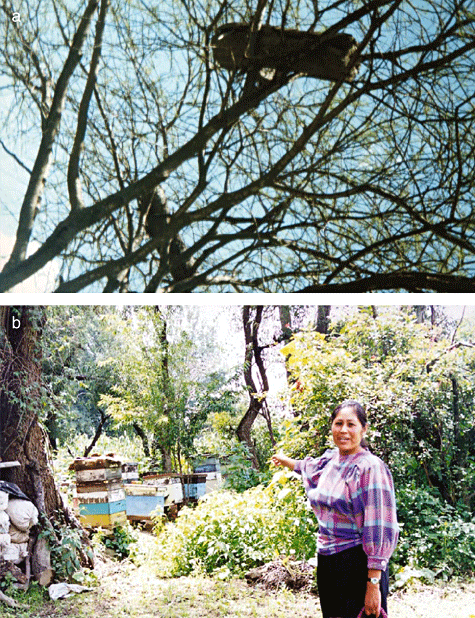
(a) Cultivation of stinging bee Apis mellifera in the Mixteca culture. (b) Cultivation of stinging bee Apis mellifera in San Francisco Totimehuacan, Puebla.
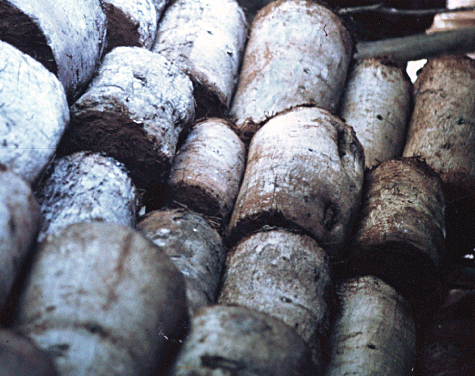
Cultivation of stingless bee Melipona beecheii in the Maya culture.
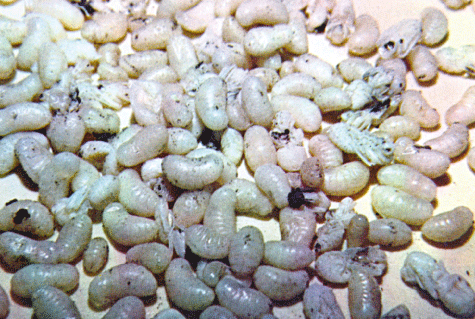
Escamoles ant reproductive cast eaten in many parts of Mexico.
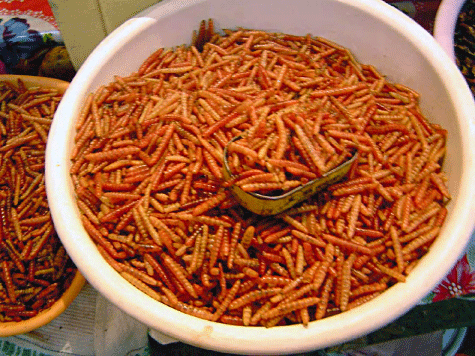
Red agave worm; larval stage ready to sell.
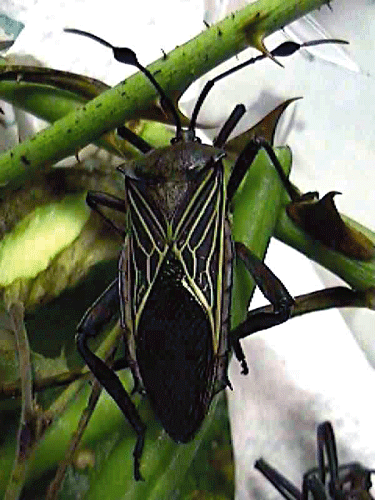
Thasus gigas protoculture in Tulancalco, Hidalgo México.
| Common Name | Scientific name | States | Ethnic groups |
|---|---|---|---|
| Bees | Apis mellifera L. Apis mellifera adamsonii Latreille, 1804 (Fig. 10a,b) | All | Mazatecos, Nahuas, Popoloca, Totonacos |
| Bumble bees | Bombus medius Cresson, B. diligens Smith | Chiapas | Chol, Lacandon, Mame, Tojolabal, Tzetzal. Tzotzil, Zoque |
| México State | Mazahua, Otomíes, Nahuas | ||
| Puebla | Mazatecos, Nahuas, Popoloca, Totonaco | ||
| Tabasco | Choles, Chontales, Zoques, Tzelzal, Tzotzil, Zoques, Lacandones | ||
| Bombus ephippiatus Say | Jalisco | Huichol, Nahuas, Purepechas | |
| Quintana Roo | Mayas, Choles, Tojolabales | ||
| Stingless beesWasps | Trigona mexicana Guérin-Meneville | Yucatán | Chol, Maya, Tzetzal |
| Melipona beecheii Bennett (Fig. 11) | Campeche | Chol, Maya, Tzetzal | |
| Chiapas | Chol, Lacandon, Mame, Tojolabal, Tzetzal. Tzotzil, Zoque | ||
| Hidalgo | Nahua, Otomí, Tepehua | ||
| Oaxaca | Mixteco, Mixe Mazateco, Nahua Zapotecos | ||
| Quintana Roo | Mayas, Choles, Tojolabales | ||
| Veracruz | Huasteco, Nahua, Mazateco | ||
| Polistes instabilis Saussure, P. parvulina Richards | México State | Mazahua, Otomíes, Nahuas | |
| Hidalgo | Nahua, Otomí, Tepehua | ||
| San Luis Potosí | Huasteco, Nahua, Pame | ||
| P. canadensis L., Polybia occidentalis nigratella Buysson | Guerrero | Amuzgo, Mixteco, Nahua | |
| Michoacán | Mazahua, Nahua, Purepecha | ||
| Veracruz | Huasteco, Nahua, Mazateco | ||
| P. occidentalis bohemani Holmgren, Epipona sp. | Chiapas | Chol, Lacandon, Mame, Tojolabal, Tzetzal. Tzotzil, Zoque | |
| Oaxaca | Mixteco, Mixe Mazateco, Nahua Zapotecos | ||
| Quintana Roo | Mayas, Choles, Tojolabales | ||
| Flies | Musca domestica L., Ephydra hians Say, Anastrepha ludens Loew, Drosophila melanogaster Meigen. | México State | Mazahua, Otomíes, Nahuas |
| Hidalgo | Nahua, Otomí, Tepehua | ||
| Butterflies | Bombyx mori L. | México State | Mazahua, Otomíes, Nahuas |
| Mexico City | Mazahua, Mixteca, Nahua, Otomí | ||
| Hidalgo | Nahua, Otomí, Tepehua | ||
| Oaxaca | Mixteco, Mixe Mazateco, Nahua Zapotecos | ||
| Tlaxcala | Nahua, Otomí, Totonaca | ||
| Spodoptera spp. | Mexico City | Mazahua, Mixteca, Nahua, Otomí | |
| México State | Mazahua, Otomíes, Nahuas | ||
| Hidalgo | Nahua, Otomí, Tepehua | ||
| Oaxaca | Mixteco, Mixe Mazateco, Nahua Zapotecos | ||
| Tlaxcala | Nahua, Otomí | ||
| Beetles | Rhynchophorus palmarum (L.) | Chiapas | Chol, Lacandon, Mame, Tojolabal, Tzetzal. Tzotzil, Zoque |
| Guerrero | Amuzgo, Mixteco, Nahua | ||
| Jalisco | Huichol, Nahuas, Purepechas | ||
| Michoacán | Mazahua, Nahua, Purepecha | ||
| Oaxaca | Mixteco, Mixe Mazateco, Nahua Zapotecos | ||
| Tenebrio molitor L., Tribolium castaneum Herbst, T. confusum Du Val, Zophobas spp. | Mexico City | Mazahua, Mixteca, Nahua, Otomí | |
| Jalisco | Huichol, Nahuas, Purepechas | ||
| Michoacán | Mazahua, Nahua, Purepecha | ||
| Mealybugs | Dactylopius coccus Costa, D. confusus (Cockerell), D. indicus (Green) | Hidalgo | Nahua, Otomí, Tepehua |
| Morelos | Mixteco, Nahua, Tlapaneco | ||
| Oaxaca | Mixteco, Mixe Mazateco, Nahua Zapotecos | ||
| Aquatic bugs | Corisella mercenaria (Say), C. texcocana Jacz, Krizousacorixa femorata Guérin, K. azteca (Jacz), Graptocorixa abdominalis (Say), G. bimaculata (Guérin) | México State | Mazahua, Otomíes, Nahuas |
| Guanajuato | Nahua, Otomí | ||
| Michoacán | Mazahua, Nahua, Purepecha | ||
| Crickets | Acheta domestica L., A. assimilis (Fabricius) | Mexico City | Mazahua, Mixteca, Nahua, Otomí |
| Guanajuato | Nahua, Otomí | ||
| Morelos | Mixteco, Nahua, Tlapaneco | ||
| Veracruz | Huasteco, Nahua, Mazateco | ||
| Cockroaches | Periplaneta australasiae (Fabricius) | Chiapas | Chol, Lacandon, Mame, Tojolabal, Tzetzal. Tzotzil, Zoque |
| Tabasco | Choles, Chontales, Zoques, Tzelzal, Tzotzil, Zoques, Lacandones | ||
| Veracruz | Huasteco, Nahua, Mazateco |
| Common Name | Scientific name | Way to obtain (State) | Ethnic groups |
|---|---|---|---|
| Wasps | Polybia occidentalis nigratella, P. o. bohemani, P. parvulina, Polistes instabilis, P. canadensis, Myscochyttarus basimacula | The colony is put close to the house (México State) | Mazahua, Otomíes, Nahuas |
| Guerrero | Amuzgo, Mixteco, Nahua | ||
| Hidalgo | Nahua, Otomí, Tepehua | ||
| Morelos | Mixteco, Nahua, Tlapaneco | ||
| Oaxaca | Mixteco, Mixe Mazateco, Nahua Zapotecos | ||
| Tlaxcala | Nahua, Otomí | ||
| Veracruz | Huasteco, Nahua, Mazateco | ||
| Escamoles ants | Liometopum apiculatum (Fig. 12), L. occidentale var. luctuoum | Take care of nests after exploiting them (Mexico City) | Mazahua, Mixteca, Nahua, Otomí |
| México State | Mazahua, Otomíes, Nahuas | ||
| Michoacán | Mazahua, Nahua, Purepecha | ||
| Nuevo León | Nahua, Otomí | ||
| Puebla | Mazatecos, Nahuas, Popoloca, Totonaco | ||
| Querétaro | Nahua, Otomí | ||
| Tlaxcala | Nahua, Otomí | ||
| Escamoles ants | Atta cephalotes | Chiapas | Chol, Lacandon, Mame, Tojolabal, Tzetzal. Tzotzil, Zoque |
| Hidalgo | Nahua, Otomí, Tepehua | ||
| Oaxaca | Mixteco, Mixe Mazateco, Nahua Zapotecos | ||
| Veracruz | Huasteco, Nahua, Mazateco | ||
| Yucatán | Chol, Maya, Tzetzal | ||
| Atta mexicana | Chiapas | Chol, Lacandon, Mame, Tojolabal, Tzetzal. Tzotzil, Zoque | |
| Hidalgo | Nahua, Otomí, Tepehua | ||
| Oaxaca | Mixteco, Mixe Mazateco, Nahua Zapotecos | ||
| White grubs | Phyllophaga mexicana Blanch, Golofa imperialis Thomson, G. pusilla Arrow | Periodically remove the excrement to follow their development (México State) | Mazahua, Otomíes, Nahuas |
| Puebla | Mazatecos, Nahuas, Popoloca, Totonaco | ||
| Red agave worm | Comadia redtenbacheri (Fig. 13) | Take from agave plant and fatten insects with “tortilla” (Mexico City) | Mazahua, Mixteca, Nahua, Otomí |
| México State | Mazahua, Otomíes, Nahuas | ||
| Guanajuato | Nahua, Otomí | ||
| Hidalgo | Nahua, Otomí, Tepehua | ||
| Michoacán | Mazahua, Nahua, Purepecha | ||
| Oaxaca | Mixteco, Mixe Mazateco, Nahua Zapotecos | ||
| Puebla | Mazatecos, Nahuas, Popoloca, Totonaco | ||
| Querétaro | Nahua, Otomí | ||
| Tlaxcala | Nahua, Otomí | ||
| Zacatecas | Huichol, Nahua | ||
| White agave worm | Aegiale hesperiaris | The L6 are gathered (Mexico City) | Mazahua, Mixteca, Nahua, Otomí |
| México State | Mazahua, Otomíes, Nahuas | ||
| Guanajuato | Nahua, Otomí | ||
| Hidalgo | Nahua, Otomí, Tepehua | ||
| Michoacán | Mazahua, Nahua, Purepecha | ||
| Oaxaca | Mixteco, Mixe Mazateco, Nahua Zapotecos | ||
| Puebla | Mazatecos, Nahuas, Popoloca, Totonaco | ||
| Querétaro | Nahua, Otomí | ||
| Tlaxcala | Nahua, Otomí | ||
| Zacatecas | Huichol, Nahua | ||
| Striped worm | Phassus triangularis, Ph. trajesa | The L6 are gathered (Mexico State) | Mazahua, Otomíes, Nahuas |
| Guerrero | Amuzgo, Mixteco, Nahua | ||
| Hidalgo | Nahua, Otomí, Tepehua | ||
| Michoacán | Mazahua, Nahua, Purepecha | ||
| Veracruz | Huasteco, Nahua, Mazateco | ||
| Xamues | Thasus gigas (Fig. 14) | Nymphs are gathered and put in trees near the house (Mexico State) | Mazahua, Otomíes, Nahuas |
| Guerrero | Amuzgo, Mixteco, Nahua | ||
| Hidalgo | Nahua, Otomí, Tepehua | ||
| Michoacán | Mazahua, Nahua, Purepecha | ||
| Oaxaca | Mixteco, Mixe Mazateco, Nahua Zapotecos | ||
| Querétaro | Nahua, Otomí | ||
| Grasshoppers | Sphenarium purpurascens Charpentier | Some areas are left without collecting (Chiapas) | Chol, Lacandon, Mame, Tojolabal, Tzetzal. Tzotzil, Zoque |
| Mexico City | Mazahua, Mixteca, Nahua, Otomí | ||
| Guerrero | Amuzgo, Mixteco, Nahua | ||
| Hidalgo | Nahua, Otomí, Tepehua | ||
| Morelos | Mixteco, Nahua, Tlapaneco | ||
| Oaxaca | Mixteco, Mixe Mazateco, Nahua Zapotecos | ||
| Puebla | Mazatecos, Nahuas, Popoloca, Totonaco | ||
| Tlaxcala | Nahua, Otomí | ||
| Veracruz | Huasteco, Nahua, Mazateco | ||
| Cuecla | Arsenura armida (Cramer) | Larvae are picked upon arriving at the L6, and some organisms are left for reproduction (Chiapas) | Chol, Lacandon, Mame, Tojolabal, Tzetzal. Tzotzil, Zoque |
| Mexico City | Mazahua, Mixteca, Nahua, Otomí | ||
| Hidalgo | Nahua, Otomí, Tepehua | ||
| Oaxaca | Mixteco, Mixe Mazateco, Nahua Zapotecos | ||
| Puebla | Mazatecos, Nahuas, Popoloca, Totonaco | ||
| Veracruz | Huasteco, Nahua, Mazateco | ||
| Cuetla | Latebraria amphypirioides Guenée | Chiapas | Chol, Lacandon, Mame, Tojolabal, Tzetzal. Tzotzil, Zoque |
| Mexico City | Mazahua, Mixteca, Nahua, Otomí | ||
| Hidalgo | Nahua, Otomí, Tepehua | ||
| Oaxaca | Mixteco, Mixe Mazateco, Nahua Zapotecos | ||
| Puebla | Mazatecos, Nahuas, Popoloca, Totonaco | ||
| Veracruz | Huasteco, Nahua, Mazateco | ||
| Tabasco | Choles, Chontales, Zoques, Tzelzal, Tzotzil, Zoques, Lacandones |
- L6 is the Last Larval Stage.
The aim of this paper is to show the origin of anthropo-entomophagy and the changes that have occurred over time.
Progress of anthropo-entomophagy
- •
There has been a change of attitude in the developed world, which has led to interest in edible insects and in becoming motivated to consume them. There has also been a push for chefs to cook and present insects as gourmet dishes with an amazing combination of different kinds of ingredients and types of insects.
- •
Nevertheless, as time passed, the prestige of edible insects has changed, and the ways to obtain them, and consequently their acquisition and offer, leads to concomitant changes that cause an evolution of anthropo-entomophagy.
- •
This gives origin to positive aspects, because edible insects can help to alleviate hunger and malnutrition in many rural populations. On the other hand, negative aspects arise because, depending on the country and place, rural dwellers or other people can over-exploit some species.
- •
In addition, there has been an inversion of values, as North Americans have sought more natural foods including edible insects, which is in contrast to people in the developing world who are looking for more processed and “junk” food.
- •
Nowadays, industries exist in different countries that process and provide different types of edible insects to people with high purchasing power (Reese Metals Company, Harada Foods Co., Chateau Brand, Holtix) (15, 16).
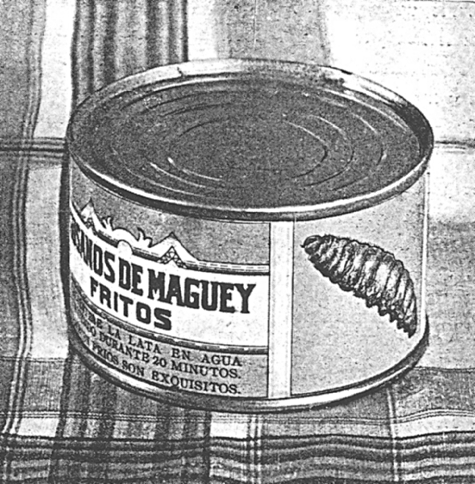
Canned white worm for exportation to Canada.
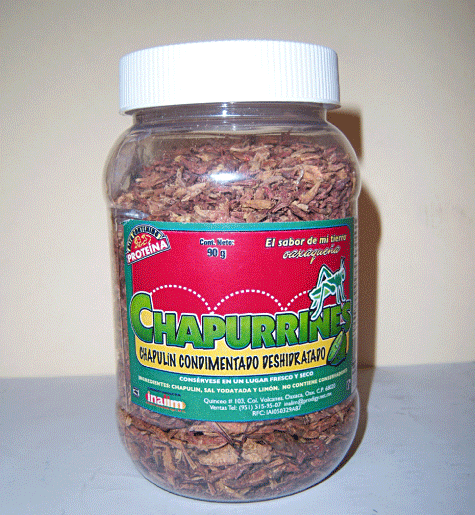
Grasshoppers from Inalim Enterprises for exportation to the USA.
There are twelve aspects that analyze the transformation and evolution that people undergo with respect to this alimentary habit:
Assemblage
The gathering of edible insects has changed from individual manual or communal collection done with primitive techniques, to a massive harvest program depending on the area and on the type of insect and season. These large collections are carried out by gangs of people, where large quantities are obtained and stored in ceramic pots or plastic mesh bags in houses. As a result, the quantities increase in a significant way (Fig. 17).
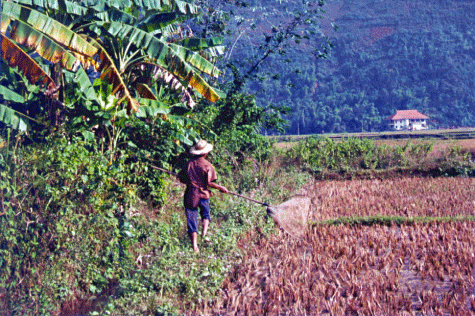
Net to collect edible insects in Valles Centrales of Oaxaca State, Mexico.
Preparation
Previously, insects were eaten alive or after they were cooked, roasted, boiled with salt or even fried by street sellers to restaurants. The restaurants would then present these foods as sophisticated gourmet dishes, having a totally changed the look and presenting them as much more attractive and savory (Fig. 18).
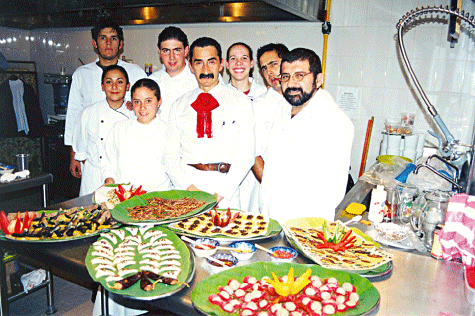
Edible insects cooked for a party organized by National Geographic in Mexico and prepared by international chefs.
Marketing
The sale of edible insects has changed from on the street or in “tianguis”, in volume, or in various measures or handfuls by rural people in formal markets (19, 20). Edible insects are now offered in specialized stores in cities, where they are sold in packages (Japan) or cans (USA, Japan, France, China, Mexico), and in restaurants.
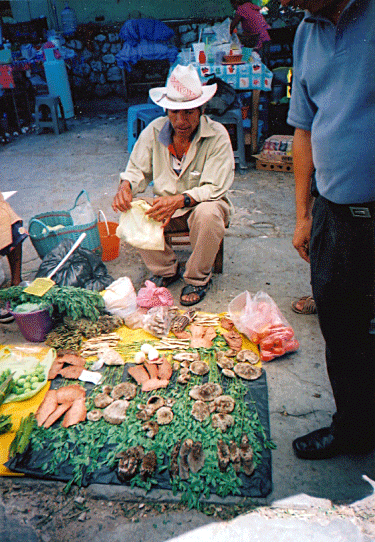
Pieces of a nest of Polybia occidentalis nigratella for sale in the day market of Acatlan de Osorio, Puebla, Mexico.
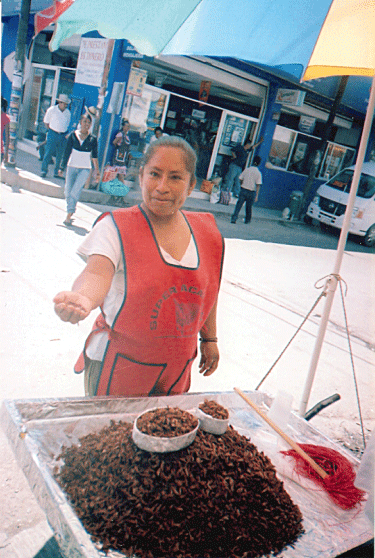
Grasshoppers for sale in the day market of Acatlan de Osorio, Puebla, Mexico.
Ingestion
The consumption of edible insects initially was local. Afterwards they were sold in different towns of the same state and later, at the national and international levels: the food was bought by people of different nationalities, ages, races and religions in luxury restaurants. Naturally, insects are cooked in very different forms, which is dependent on the chef and on the purchasing power of the people of each location.
Psychological
This aspect includes the rejection of edible insects from cultures in developed countries (USA, Canada, EU) to its current acceptance and high demand because they are in fashion and people now know the qualities of edible insects. There has been a change in thinking: edible insects used to be considered “barbarian food”, but now insects have achieved a significant reputation and are considered a luxury (Fig. 21).
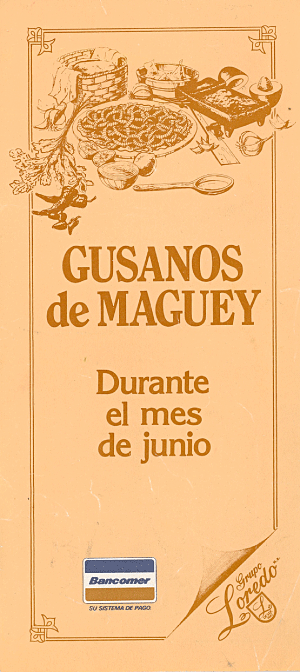
Publicity for edible insects (“White agave worm, during the month of June“) which can be eaten in the Loredo Group restaurants in Mexico City and which are advertised by the Bancomer bank.
Sociological
Edible insects used to be considered “Indian food” and/or a food of “slaves”, which put insects at the level of “low prestige food” and were refused by other people. However, insects are eaten by the wealthy elites of various countries, who have designed them as a “high prestige food” and even given them a special place as a “cultural dish”.
Economic
Edible insects used to be offered in restaurants in small towns or those that were located along roads. Now, they appear in the menu of five-star restaurants, with a substantial increase in their price, which results in the selling of huge quantities of edible insects.
Insects in Nature
The collection of edible insects is in small amounts for eating at lunch time. Until the search of a particular species can be obtained by tons, they will use some of the samples to eat, some to store in their houses, and the rest for sale. This would earn them some very important money, or set up a culture of enterprise in a different scale (22, 23).
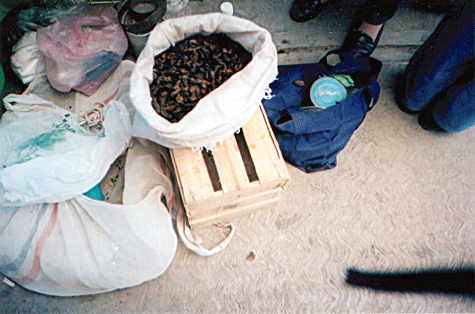
Bags containing 50 kg of Arsenura armida larvae preboiled in salty water.

Storage of eggs of edible aquatic Notonectidae and Corixidae called “Ahuahutle”.
Chronological
Edible insects used to be food for hunter–gatherers, but today are a “modern, luxurious food”, at times described as “exotic” and sought by wealthy tourists (Fig. 24).
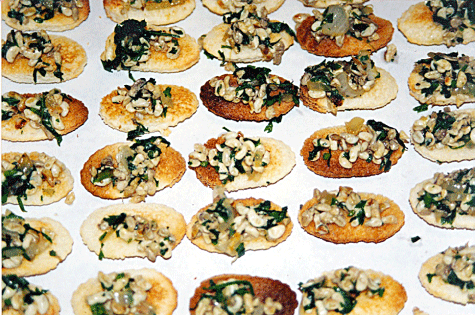
Escamoles ants, inmature states of reproductive cast fried in butter with parsley on bread fried in olive oil with garlic.
Organoleptical
Edible insects used to be cooked alone, without any dressing, retaining their original flavor. Now there is a synergism in presentations with different ingredients and flavors, mixed with plants or spices and highlighted by chefs (Fig. 25).

Fortino chef at the “Fonda Don Chon” restaurant showing a soup of fried maize crepes spiced with a sauce of fresh tomatoes and fried grasshoppers.
Veterinary
From having cattle fed naturally to nourishing the animals with processed food, to obtaining raised insects that constitute principally the protein part of the ration, by recycling organic wastes.
Educational
This last aspect is very important because many people in various countries are ignorant of and have a disdain for edible insects, primarily developed countries. Nowadays, specialized courses are offered in these countries at high school, professional or graduate levels (e.g. USA, Australia, Germany, Mexico, Brazil). On occasion, such courses are included formally in first degrees and primary school. In some schools, Edible Insect Day has even been established, where children explore the field to seek, gather and prepare insects. It is very important to preserve this natural resource.
Sustainability of edible insects
Because of the significant development in anthropo-entomophagy, sustainability of insect species is fundamental. Therefore, it is necessary to take certain measures for species conservation:
- •
Rural dwellers, who live in the field and gather edible insects sequentially throughout the year, know very well the time and places to obtain them, the expected quantities, the preferred stage or sex, size, type, schedule, host plants, dangers, type of material used in their capture and productive time. In light of this, ethno-entomological knowledge has significant value that we need to use in order to obtain the sustainability of edible insects, as has occurred in many locations where our studies were focused.
- •
More than 100 species of edible insects in Mexico can be tested for their sustainability over 500 years by studying the codices and manuscripts sent to Spain by the chroniclers. There exists in Puebla State a sustainable protoculture of Paradirphia fumosa (Felder) and in Chiapas State, those of Arsenura armida (Cramer).
Conservation of edible insect species
For the conservation of the species, it would be necessary to consider some factors:
- •
Correct identification of species.
- •
Literature searched.
- •
Geographical location (range from its territory).
- •
Type of nutrition.
- •
Range of temperature, humidity and altitude.
- •
Knowledge of lifecycle.
- •
Knowledge of population density.
- •
Dates for optimal exploitation, avoiding species risk.
- •
Knowledge of survival rate and degree of parasitism or predation.
- •
Investigation of the existence of a protoculture.
- •
A study, plan and implementation of formal culture.
However, above all to save lives, it is necessary to conserve biodiversity and ecosystems. Only in this way can we achieve the preservation of natural renewable resources.
Conclusion
As we can remark, edible insects are a natural renewal resource that merit deep study in order to deliver more food and especially proteins to people with poor nutrition. It is also necessary to cultivate some species to continue to sustain them.




